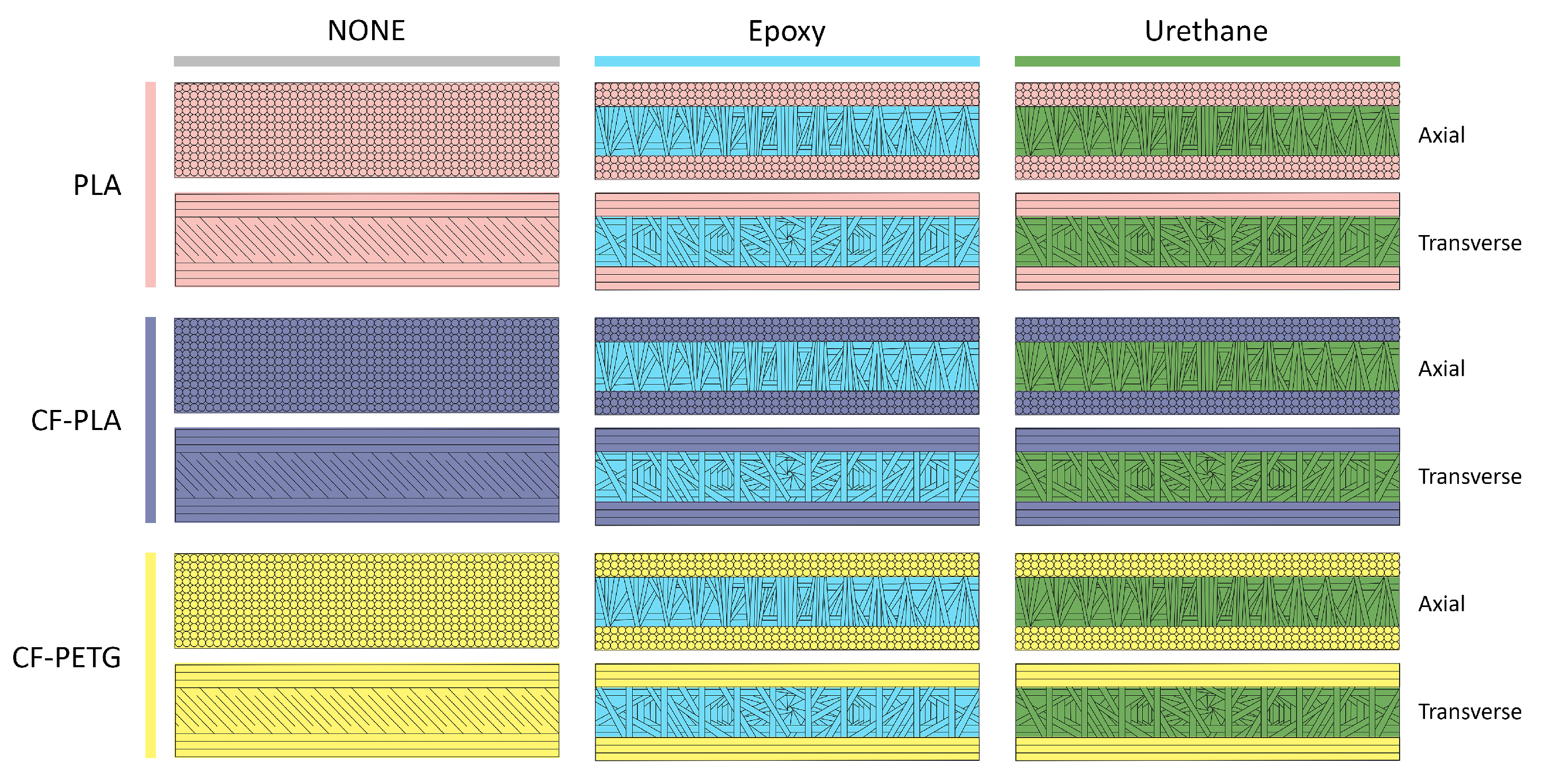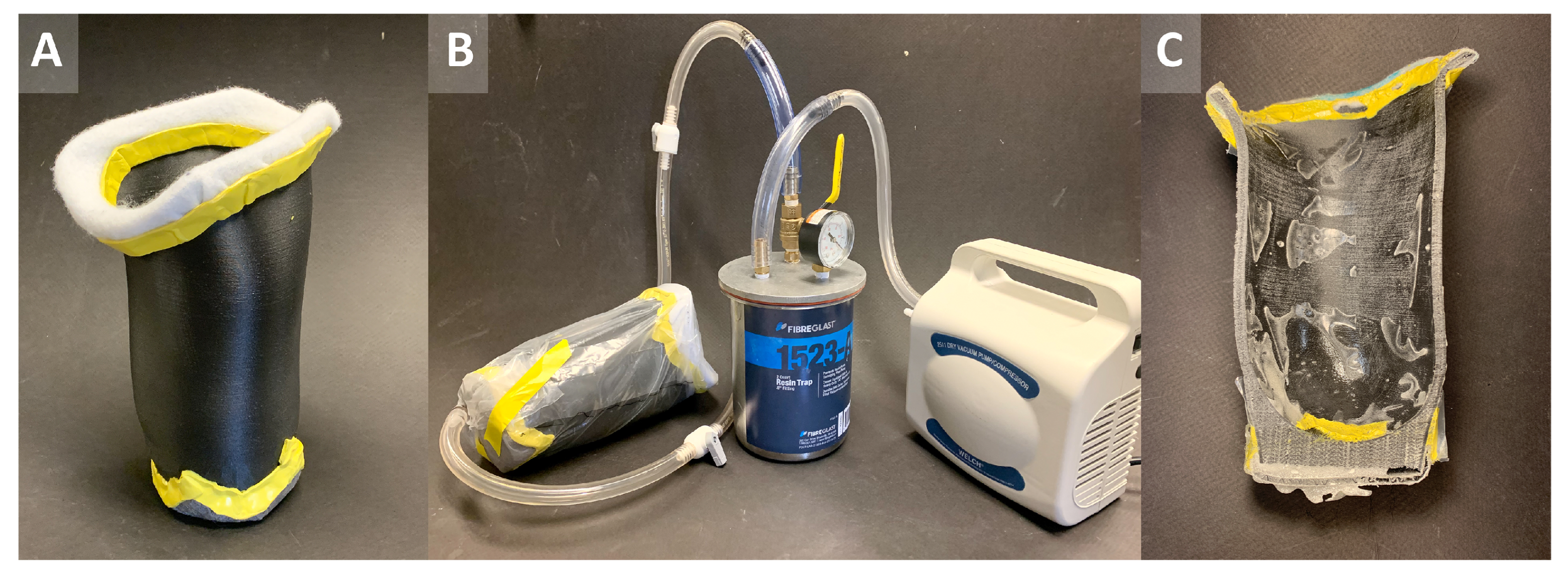5.1. Comparison with Theoretical Models—Rule of Mixtures
For simple first order approximations of the mechanical properties of composite materials, the Voigt and Reuss models (referred to as the Rule of Mixtures) are often used to predict material properties [
41]. For unidirectional composites reinforced axially, the contribution of each material to the final property is proportional to the volume fraction of each component (Equation (
1)).
In this Equation,
P is a property and
V denotes volume fraction. The subscript
c indicates the composite, and the subscript
i indicates the ith component of a total of
n components. For a simple two phase composite
n = 2 where the property
P is the Young’s Modulus
E, the equation simplifies to Equation (
2):
For unidirectional composites loaded transversely, the model of the system changes because the components are under equal stress leading to Equation (
3).
Again, for a simple two phase composite
n = 2 where the property
P is the Young’s modulus
E, the equation simplifies to Equation (
4):
Because equal stress conditions are less realistic than equal strain, the Reuss model for transverse loading will always be less accurate than the Voigt Model for axial loading [
41].
Unfortunately, both of these models are not sufficient to account for the complexity of the mechanical behavior in most composite materials. This is especially true when interfacial failure, void presence, fiber misalignment, statistical dispersion among other defects are considered [
22,
42,
43]. Critically, the porosity in the matrix must be accounted for. The relative density of porosity is the single most important factor affecting the mechanical properties of porous materials [
44].
For this research, simple modifications to the Rule of Mixtures are proposed. The materials studied are simple two phase composites, but have additional complexity due to additive manufacturing and vacuum infiltration induced defects. Modified Rule of Mixtures (MRoM) equations for axial loading are presented below (Equations (
5) and (
6)).
E and
refer to the Young’s modulus and ultimate tensile strength, respectively. The subscripts
c,
f, and
m refer to the composite, filament material, and infiltrated matrix. For materials with porosity relative densities > 0.3, voids behave as isolated pores in a solid. Previous theoretical and experimental studies have shown that a term
can be applied to the matrix as a "porosity correction factor" [
40,
43]. Here
is the volume fraction of porosity.
describes the Krenchel fiber orientation efficiency factor of the filaments in the matrix [
45] (Equation (
7)). In this equation,
is the angle between groups of parallel filament fibers and the load direction.
is the fraction of filament fibers oriented at
.
Simple application of this orientation efficiency factor would result in zero contribution from filament fibers perpendicular to the load direction. This is not true, and corrections such as the ten percent rule [
46] bound the failure envelope for fiber reinforced composites. In additively manufactured materials, the volume fraction of filament fibers are very high (often continuous) meaning there will be a significant transverse response. To account for this, it is more appropriate to bound this envelope by the ratio of anisotropy for each relevant property
, where
and
are the transverse and axial properties of interest. This leads to a modified Krenchel efficiency factor (Equation (
8)):
The equations for transverse loading are similar to those of the Reuss model. In this case, all correction factors
and
, move to the denominator of Equation (Equations (
9) and (
10)).
Table 7 and
Table 8 plus
Figure 13 summarize the expected values for stiffness and ultimate tensile strength calculated using the Rule of Mixtures (RoM) and Modified Rule of Mixtures (MRoM). The input material properties for RoM and MRoM are found in
Table 1 with a volume fraction of 0.584 for the filament fibers and 0.416 for the volume fraction of resin. The MRoM model utilizes an assumed porosity
of 0.03, while values for
were calculated using filament anisotropy values reported in
Table 4 and raster pattern geometry.
Examination of the values for axial stiffness and strength,
Table 7 plus
Figure 13, show that both the RoM and MRoM over predict the axial ultimate tensile strength of the composite materials. This is consistent with previous applications of RoM and MRoM models [
42,
43,
47]. The MRoM better predicts the axial UTS in every case, but still over predicts strength by a large margin. Prediction of axial stiffness is much better than the strength predictions with relative error being as low as 0.8% for PLA + Epoxy. The MRoM had a slight edge in this case with a lower average error. Notably, CF PLA + Epoxy outperformed the predicted stiffness for both RoM and MRoM models with relative errors of −7.3% and −13.4% respectively.
Inspecting the transverse values of stiffness and strength,
Table 8 plus
Figure 13, it is clear that the RoM over predicts both material properties by a large margin. The values predicted by the RoM model are significantly different from the experimentally reported values. The MRoM model more accurately predicts the transverse stiffness and strength in every single case. The MRoM consistently underpredicts the transverse stiffness by a small margin and overpredicts the transverse tensile strength by a larger margin. Interestingly, CF PLA + Urethane as well as CF PETG + Urethane outperform their strength predictions from the MRoM model with relative errors of −3.5% and −71.6% respectively.
While the results of the RoM and MRoM models are interesting and useful for predicting properties of novel composite materials, they are limited in their effectiveness. As a first order approximation, the RoM model typically describes the theoretical upper and lower bounds of composite strength and stiffness [
41]. The MRoM model improves on this by including some geometric factors and defects into account, but more elaborate models have been proposed. Prediction of material properties could be improved by utilizing models such as the Volume Average Stiffness (VAS) method [
43,
48,
49].
5.2. Impact on Additive Manufacturing
The novel composite materials developed in this work have many implications for additive manufacturing. Often it is not possible to print components in a favorable raster orientation due to machine limitations. In every single case tested in these experiments, it was observed that the stiffness anisotropy due to additive manufacturing was reduced. This means that when operating under linear elastic conditions, engineers and designers have more geometric freedom for designing additively manufactured components. The reduction in stiffness anisotropy means that parts can be loaded in more configurations. Similarly, the strength anisotropy was reduced in every single case tested except one (PLA + Urethane). In this outlier, the specific strength of the material actually increased. This makes a strong case that vacuum infiltration improves the isotropy properties of these materials. For both stiffness and strength, this internal reinforcement impacted the transverse loading condition more dramatically than the axial loading condition. Since the transverse loading direction is the weakest, any improvements in transverse stiffness or strength improve the usefulness of a material matrix combination.
Importantly, there are limitations to this vacuum reinforcement method for additive manufacturing. First, not every geometry that can be additively manufactured can be vacuum infiltrated because of the need for surrounding the part with vacuum bagging. In addition, the observed porosity in these experiments was the cause of failure for most infiltrated specimens, while some degree of porosity is inevitable, the strength of these composites could be much better if processing conditions were improved to reduce the number and size of voids. Other limitations include leakage of resin through the walls of 3D printed parts. This issue was not significant enough to drastically change the intended geometry but would require post-processing such as sanding to clean off. Other remnants of the vacuum infiltration process such as the sealant tape and the vacuum bagging themselves also need to be cleaned before the parts could have an acceptable surface finish. Still, vacuum infiltration is much better suited to reinforcement of large scale components than fill compositing [
8] thus many of these limitations are still outweighed by the method’s benefits.
5.3. Feasibility for Manufacturing Prosthetic Sockets
Since the data presented in the experiments was promising, especially for the CF PLA + Urethane and CF PETG + Urethane combinations, the next step was to evaluate the feasibility of using vacuum infiltration to reinforce an additively manufactured prosthetic socket. A transtibial prosthetic socket was 3D printed utilizing CF PETG as the filament material with a wall thickness of 5 mm and raster pattern identical to the printed test sheets (
Figure 14A). The distal and proximal ends of the printed socket were sanded to reveal the underlying infill layer, then breather and bleeder cloths were affixed using sealant tape. The entire assembly was infiltrated with Urethane using the same method as the printed test sheets (
Figure 14B). After curing, the sample was cut in half to inspect the cross section (
Figure 14C).
Overall, this socket represents a successful proof of concept for strengthening additively manufactured prosthetic sockets with vacuum infiltration. The final socket retained the geometry of the CAD file without visible deformation. Inspection of the cross section revealed that there were no significant voids within the main body of the socket. There was one void at the interface of the socket and the resin jacket, but this section does not represent the interior of the socket and would be removed entirely in post preparation. This means that the mechanics of the prosthetic socket should reflect the data presented earlier in the paper. The improved transverse material properties will reduce the risk of catastrophic failure under non-ideal loading conditions and increase the safety of sockets manufactured with this technology. In addition, this vacuum infiltration method is similar to methods used to create fiber reinforced prostheses (e.g., fiberglass and carbon fiber) so it would possible to implement in a clinical setting. The final weight of the vacuum infiltrated socket was 633 g, comparable with a conventionally manufactured carbon fiber socket for the same patient geometry at 668 g.
However, there are limitations to this proof of concept. As manufactured, the prosthetic socket can not be worn without additional post processing. The overall surface finish was moderately rough with several areas where resin had leaked through the printed part (around 1 mm in height). These would need to be cleaned, along with removal of the sealant tape. A stronger vacuum pump and specialized vacuum bags could be utilized in the future to alleviate these issues. Questions remain such as whether the mechanical strength will be significantly compromised when attaching other components. In addition, many single use items are involved in vacuum reinforcement process so the cost effectiveness of using this technology at scale is unknown. Still, because these composite materials improve the transverse mechanical strength they are worth further investigation and merit full scale experiments to identify structural behavior.




















